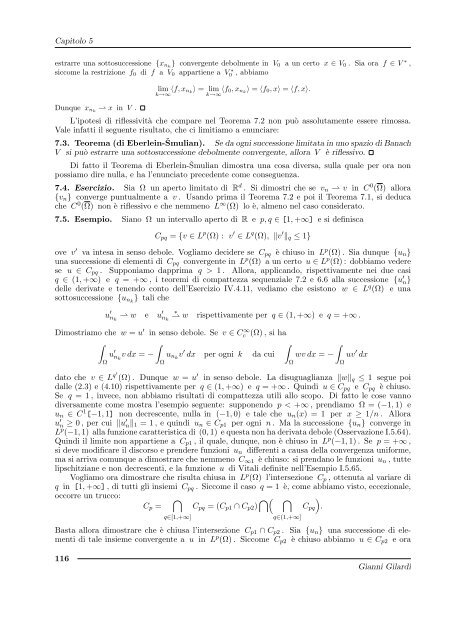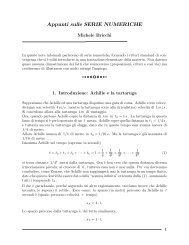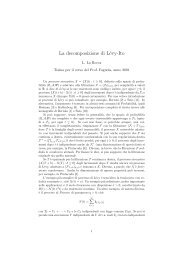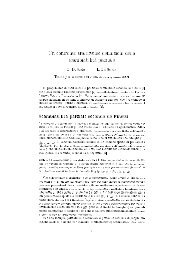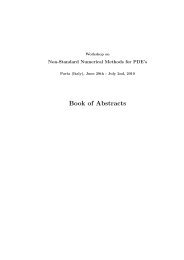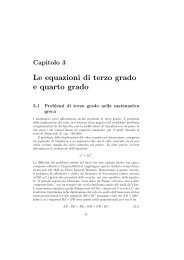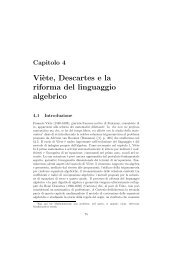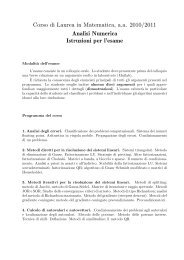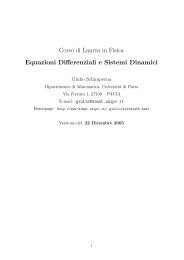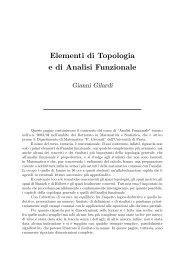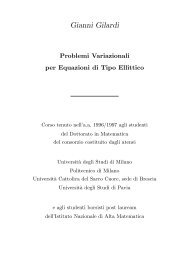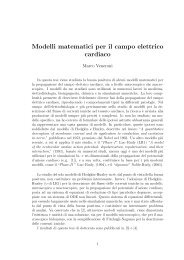G. Gilardi, Analisi Funzionale - Dipartimento di Matematica
G. Gilardi, Analisi Funzionale - Dipartimento di Matematica
G. Gilardi, Analisi Funzionale - Dipartimento di Matematica
You also want an ePaper? Increase the reach of your titles
YUMPU automatically turns print PDFs into web optimized ePapers that Google loves.
Capitolo 5<br />
estrarre una sottosuccessione {xnk } convergente debolmente in V0 a un certo x ∈ V0 . Sia ora f ∈ V ∗ ,<br />
siccome la restrizione f0 <strong>di</strong> f a V0 appartiene a V ∗<br />
0 , abbiamo<br />
Dunque xnk ⇀ x in V .<br />
lim 〈f, xnk 〉 = lim<br />
k→∞ k→∞ 〈f0, xnk 〉 = 〈f0, x〉 = 〈f, x〉.<br />
L’ipotesi <strong>di</strong> riflessività che compare nel Teorema 7.2 non può assolutamente essere rimossa.<br />
Vale infatti il seguente risultato, che ci limitiamo a enunciare:<br />
7.3. Teorema (<strong>di</strong> Eberlein-ˇSmulian). Se da ogni successione limitata in uno spazio <strong>di</strong> Banach<br />
V si può estrarre una sottosuccessione debolmente convergente, allora V è riflessivo.<br />
Di fatto il Teorema <strong>di</strong> Eberlein- ˇ Smulian <strong>di</strong>mostra una cosa <strong>di</strong>versa, sulla quale per ora non<br />
possiamo <strong>di</strong>re nulla, e ha l’enunciato precedente come conseguenza.<br />
7.4. Esercizio. Sia Ω un aperto limitato <strong>di</strong> R d . Si <strong>di</strong>mostri che se vn ⇀ v in C 0 (Ω) allora<br />
{vn} converge puntualmente a v . Usando prima il Teorema 7.2 e poi il Teorema 7.1, si deduca<br />
che C 0 (Ω) non è riflessivo e che nemmeno L ∞ (Ω) lo è, almeno nel caso considerato.<br />
7.5. Esempio. Siano Ω un intervallo aperto <strong>di</strong> R e p, q ∈ [1, +∞] e si definisca<br />
Cpq = {v ∈ L p (Ω) : v ′ ∈ L q (Ω), �v ′ �q ≤ 1}<br />
ove v ′ va intesa in senso debole. Vogliamo decidere se Cpq è chiuso in L p (Ω) . Sia dunque {un}<br />
una successione <strong>di</strong> elementi <strong>di</strong> Cpq convergente in L p (Ω) a un certo u ∈ L p (Ω) : dobbiamo vedere<br />
se u ∈ Cpq . Supponiamo dapprima q > 1 . Allora, applicando, rispettivamente nei due casi<br />
q ∈ (1, +∞) e q = +∞ , i teoremi <strong>di</strong> compattezza sequenziale 7.2 e 6.6 alla successione {u ′ n}<br />
delle derivate e tenendo conto dell’Esercizio IV.4.11, ve<strong>di</strong>amo che esistono w ∈ Lq (Ω) e una<br />
sottosuccessione {unk } tali che<br />
u ′ nk ⇀ w e u′ nk<br />
∗<br />
⇀ w rispettivamente per q ∈ (1, +∞) e q = +∞ .<br />
Dimostriamo che w = u ′ in senso debole. Se v ∈ C ∞ c (Ω) , si ha<br />
�<br />
Ω<br />
u ′ nkv dx = −<br />
�<br />
unk<br />
Ω<br />
v′ dx per ogni k da cui<br />
q∈[1,+∞]<br />
�<br />
Ω<br />
q∈(1,+∞]<br />
�<br />
wv dx = − uv<br />
Ω<br />
′ dx<br />
dato che v ∈ Lq′ (Ω) . Dunque w = u ′ in senso debole. La <strong>di</strong>suguaglianza �w�q ≤ 1 segue poi<br />
dalle (2.3) e (4.10) rispettivamente per q ∈ (1, +∞) e q = +∞ . Quin<strong>di</strong> u ∈ Cpq e Cpq è chiuso.<br />
Se q = 1 , invece, non abbiamo risultati <strong>di</strong> compattezza utili allo scopo. Di fatto le cose vanno<br />
<strong>di</strong>versamente come mostra l’esempio seguente: supponendo p < +∞ , pren<strong>di</strong>amo Ω = (−1, 1) e<br />
un ∈ C1 [−1, 1] non decrescente, nulla in (−1, 0) e tale che un(x) = 1 per x ≥ 1/n . Allora<br />
u ′ n ≥ 0 , per cui �u ′ n�1 = 1 , e quin<strong>di</strong> un ∈ Cp1 per ogni n . Ma la successione {un} converge in<br />
Lp (−1, 1) alla funzione caratteristica <strong>di</strong> (0, 1) e questa non ha derivata debole (Osservazione I.5.64).<br />
Quin<strong>di</strong> il limite non appartiene a Cp1 , il quale, dunque, non è chiuso in Lp (−1, 1) . Se p = +∞ ,<br />
si deve mo<strong>di</strong>ficare il <strong>di</strong>scorso e prendere funzioni un <strong>di</strong>fferenti a causa della convergenza uniforme,<br />
ma si arriva comunque a <strong>di</strong>mostrare che nemmeno C∞1 è chiuso: si prendano le funzioni un , tutte<br />
lipschitziane e non decrescenti, e la funzione u <strong>di</strong> Vitali definite nell’Esempio I.5.65.<br />
Vogliamo ora <strong>di</strong>mostrare che risulta chiusa in Lp (Ω) l’intersezione Cp , ottenuta al variare <strong>di</strong><br />
q in [1, +∞] , <strong>di</strong> tutti gli insiemi Cpq . Siccome il caso q = 1 è, come abbiamo visto, eccezionale,<br />
occorre un trucco:<br />
Cp = �<br />
Cpq = (Cp1 ∩ Cp2) �� � �<br />
.<br />
Basta allora <strong>di</strong>mostrare che è chiusa l’intersezione Cp1 ∩ Cp2 . Sia {un} una successione <strong>di</strong> elementi<br />
<strong>di</strong> tale insieme convergente a u in L p (Ω) . Siccome Cp2 è chiuso abbiamo u ∈ Cp2 e ora<br />
116<br />
Cpq<br />
Gianni <strong>Gilar<strong>di</strong></strong>


